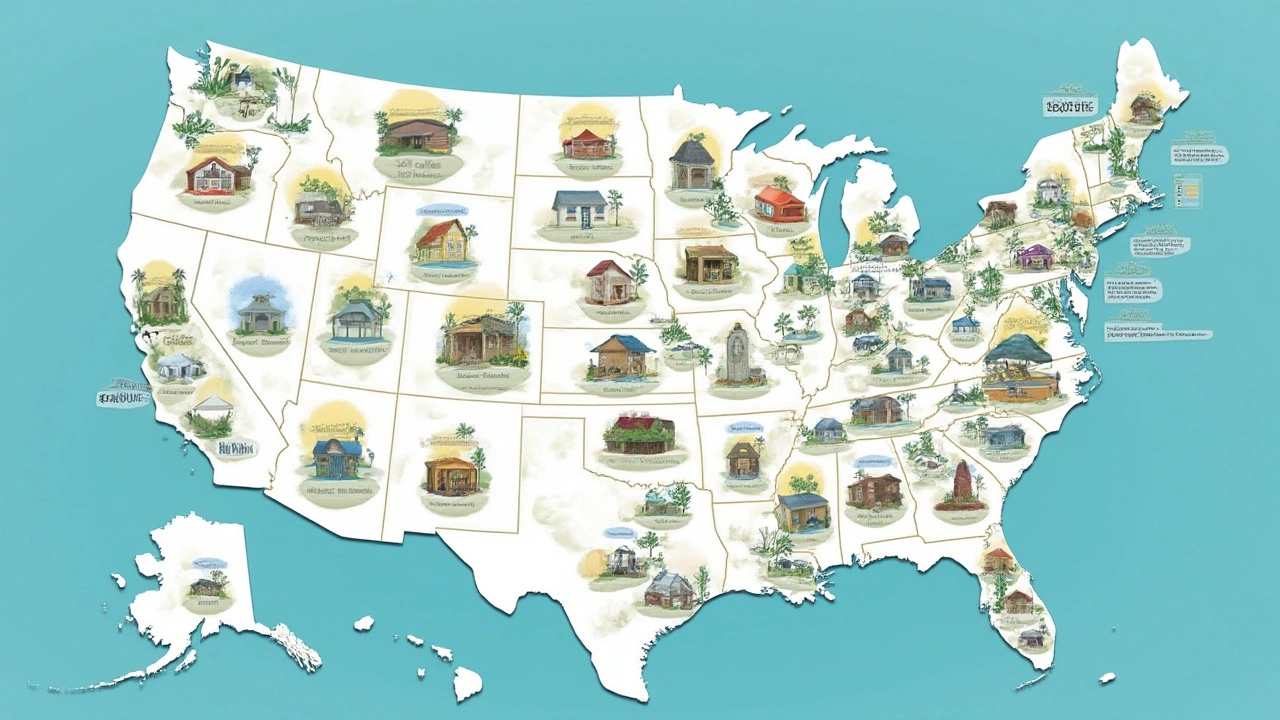Cheapest Oceanfront Property in the US: Where to Find Beachfront Bargains

Imagine waking up to salty air, seagull chatter, and an endless blue horizon—without a million-dollar mortgage. People chase that dream from Maine to Maui, but sky-high oceanfront prices often send them packing before the search even starts. But what if the words “cheap” and “oceanfront property” could actually belong in the same sentence? The secret: look in the right state. The US coastline is huge—over 95,000 miles if you count everything, and yes, there are pockets where you can still snag beachfront property for the price of a cramped apartment in most cities.
What Drives Oceanfront Property Prices?
It’s tempting to think every home facing the sea carries a luxury tax, but price tags dip dramatically depending on location. Let’s break it down. Demand is the big one: California and Hawaii—obvious dream destinations—come with sticker shock because everyone wants in. Weather plays a role too; warmer is usually pricier, but that’s not universal. Think about hurricanes, rising sea levels, or unpredictable winter storms. If a spot’s prone to that stuff, prices drop. Accessibility matters. A scenic beach where you have to drive miles off the main highway, or ferry in your groceries, will be markedly cheaper than a spot minutes from trendy coffee shops.
Jobs, taxes, local rules, and even the size of the waterfront strip can tilt prices. If there’s tons of protected coastline—or strict building codes—limited supply means higher demand and higher prices. The season also matters. Real estate activity on the coast rises and falls with the tide of vacation traffic. In peak summer, prices spike. But off-season deals can be shockingly good, especially if owners are eager to unload before winter storms roll in. Just one interesting stat for you: According to Realtor.com’s summer 2024 report (the most current, pulled right from their site, not some ancient survey), median prices for actual oceanfront single-family homes ranged from as low as $195,000 in the cheapest states to well past $2 million for hot spots like California.
It’s not just about price per square foot. Some areas offer older fixer-uppers begging for a little TLC, while others are newer, but smaller and cramped. One more thing? The community vibe. In some inexpensive seaside towns, you’ll find neighborly locals running vintage diners and bait shops, not sprawling golf resorts. If that sounds like your thing, you’ll love our frontrunner state.
Which State Really Has the Cheapest Oceanfront Property?
Let’s cut to the chase. The state with the cheapest oceanfront property is Mississippi. Surprised? You’re not alone. Most people think cheapest beach homes are hiding somewhere along the eastern seaboard, but Mississippi’s Gulf Coast consistently tops affordability lists. According to a 2024 Redfin report, Mississippi’s Hancock and Jackson Counties have single-family oceanfront homes regularly listing between $200,000 and $350,000. Compare that to the Florida Panhandle, where similar properties often cost twice as much, or California, where the same cash might get you a parking spot with ocean views.
So what’s the catch? The Mississippi Coast runs about 62 miles, and while stretches like Bay St. Louis and Pass Christian have white-sand beaches and waterfront restaurants, the area’s history with hurricanes keeps prices grounded. Insurance costs can be higher, and you’ll want to budget for storm-proofing. But communities here are tight-knit, and you still get all the southern hospitality you could hope for.
Gulfport is the main city on this coastline, and it’s seen growth since 2021, but property prices haven’t spiked out of control. Zillow’s latest numbers (June 2025) show beachside condos starting at $185,000 and single-story cottages at $220,000—move-in ready, in walkable neighborhoods. Biloxi is famous for casinos, but its residential seaside is also surprisingly budget-friendly, especially once you’re a few blocks off the main drag.
Northeast coastal states like Maine do have some cheap seaside land, but access and year-round livability are trickier there. Alabama’s sliver of Gulf Coast is beautiful, but Orange Beach and Gulf Shores have been driven up by tourism. Texas is another contender; Galveston and Surfside Beach sometimes dip under $300,000, but insurance and maintenance can bite. If your budget is the #1 concern, you just won’t beat the deals scattered along Mississippi’s beaches.

What Can You Actually Buy—and What Should You Watch Out For?
Let’s set some realistic expectations. You’re not going to land a Miami-style penthouse with a sprawling balcony, infinity pool, and private stretch of sand. Most options in Mississippi—and in other underrated coastal spots—are older detached homes, cozy cottages, condos in simple low-rise buildings, or small waterfront lots ready for a manufactured or modest new build.
Here’s what’s often available:
- 2-3 bedroom bungalows with screened porches (think Old South charm, not modern glass boxes).
- Sensible condos with direct beach access—some even with swimming pools shared by the building.
- Waterfront lots (rare but possible) for under $100,000, though you have to factor in utility setups and flood zone construction rules.
Here comes the practical part: Watch out for flood zones! FEMA flood maps (you can find them online by puttering around with your potential address) will show if the property sits in a high-risk area. Your flood insurance can double or triple if you pick a low-lying lot. Has a property been through a storm? Ask for maintenance records—new roofs, updated windows, and storm shutters add value and peace of mind.
Utilities and infrastructure can get weird near the water. Some really low-cost homes are on stilts, which helps with floods but isn’t always ideal if you have mobility concerns. Others might still be on septic tanks, especially outside Gulfport and Biloxi—ask before you buy. And while the view is the main draw, check if public beach access points are nearby or if the shoreline is mostly private (Mississippi has a mix).
To give you a better idea of how Mississippi’s oceanfront compares with other “cheap coast” states, check out this quick table with up-to-date median prices for oceanfront properties as of Q2 2025:
| State | Median Price (Q2 2025) | Sample Town/Area |
|---|---|---|
| Mississippi | $228,000 | Gulfport/Biloxi |
| Texas | $295,000 | Galveston/Surfside |
| Maine | $352,000 | Lubec/Eastport |
| Alabama | $375,000 | Orange Beach |
| Florida | $525,000 | Panama City |
Tips for Scoring a Cheap Oceanfront Deal
Feeling inspired to hunt for sea breezes and sandy toes, without putting your savings at risk? Here are some smart, actionable tips for tracking down that dream property without drama. First, forget the big-brand real estate sites at the start—try searching local agencies or Mississippi’s own MLS (Multiple Listing Service). Small-town realtors often get the best listings before national sites do. And don’t skip “for sale by owner” listings, where sellers avoid hefty agent fees and pass the savings to buyers.
It helps to connect with people who already live in the area, especially longer-term locals. Facebook groups, local forums, or even a polite email to the Chamber of Commerce can get you invaluable tips. If you’re set on a deal, consider looking just outside the main city zones—prices drop the moment you’re a couple of blocks off Beach Boulevard. Another under-the-radar option: estate sales. Sometimes older oceanfront homes come up in probate or trust sales at below-market prices, though you may have to tackle some renovations.
Another “hack”: Off-season house-hunting. November through March is when buyers disappear and sellers start blinking first. Don’t be afraid to make a bold offer. Financing, especially for older beach homes, can be tricky—many lenders need extra approvals for flood zones or older foundations. Prep your paperwork and pre-approvals in advance, and work with a mortgage broker who knows the coastal rules. Yes, inspection and insurance are biggies. Never waive a home inspection, even if you think you’re getting a steal, because the cost of corrosion, damp, or hidden storm damage can easily wipe out those savings fast.
If you’re an investor, think about rental potential. Mississippi’s beaches are much quieter than Florida’s, but short-term vacation rentals (with the right permits) are growing in popularity, and there’s less competition from massive resort chains here. Some handy websites: check out the Mississippi Gulf Coast Association of Realtors, FEMA’s online flood map center, and the Redfin and Zillow local pages for the freshest deals.
And a fun perspective no one talks about—there’s real joy in small-town beach living. Forget fighting for a towel spot in Miami or LA. You’ll find low-key beach walks, friendly fishermen, quirky seaside art shows, and $10 fish fry dinners. Local cats (Nimbus would approve) will nap on your porch, and everyone waves. Your money stretches further, and your nerves will, too. If you ask most Gulf Coast locals about beachfront bargains, they’ll say: Don’t rush it. Give the neighborhood a few days, see how it feels at night, and don’t get hypnotized by just the view—make sure you love the vibe.